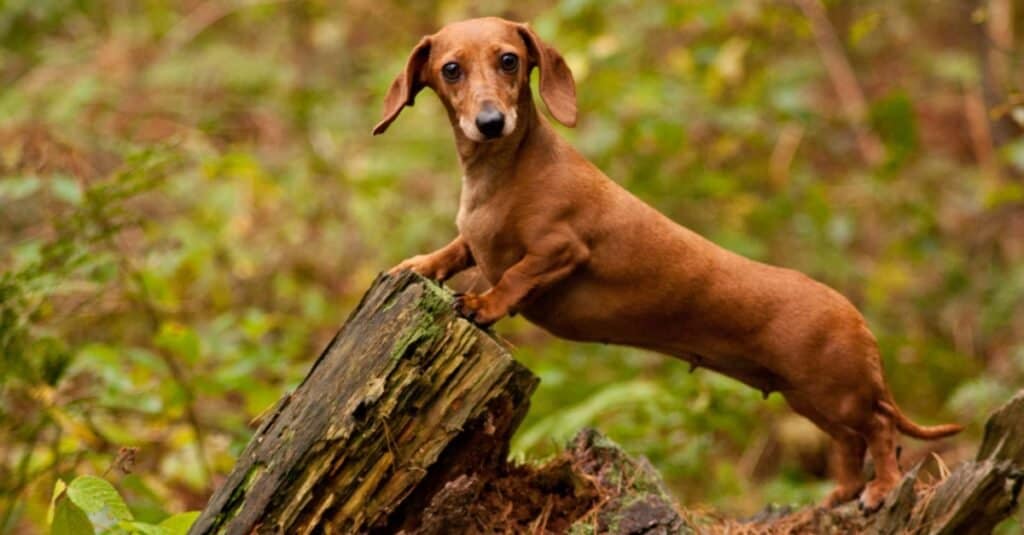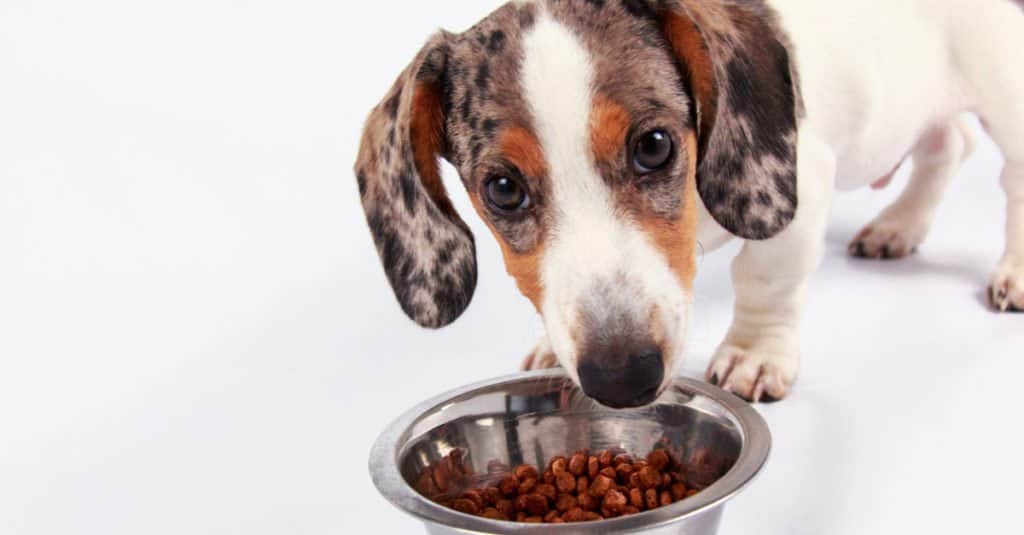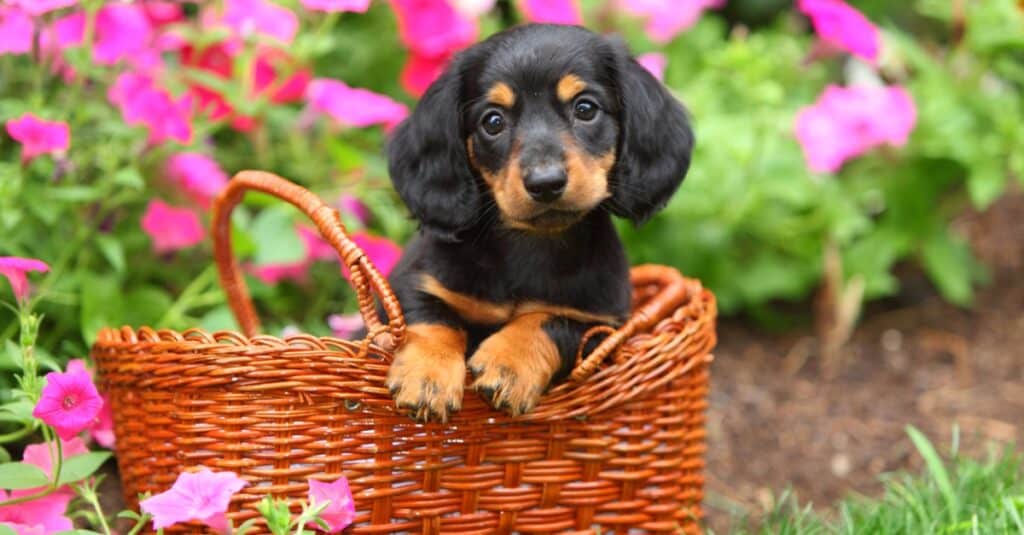If you’re taking home a new dachshund puppy, you may be excited and a bit nervous. There’s so much to learn about puppy development and how to be a good pet parent.
We’ve got you covered in the following article, where you’ll learn all about dachshund progression and what to expect throughout your puppy’s development.
Read on to learn more!
Dachshund: Breed Summary
While dachshunds are certainly cute and cuddly, they’re also extremely adept hunters. And it makes sense, as that’s what they were bred for! A German-originated breed, the translation of dachshund means “badger dog”, as these small but feisty little dogs were bred to hunt similarly small but feisty badgers.
Various types of badger-hunting dogs have existed in Europe since around the 1500s, but according to the Dachshund Club of America, the breed we know today took shape between 1700 through the early 1800s. The first variation appearing in the German record is the smooth-coated dachshund, followed by wirehaired and longhaired variations. By 1879, the modern dachshund had become quite popular in Germany, and a set breed standard developed.
Much of the breed standards described by the AKC enhance the dachshund’s ability to burrow into a badger den and engage in a dangerous, close-quarter hunt. According to the AKD, for example, the forequarters of this breed should be ideal for digging into dens and maneuvering in tight spaces. The body should be generally low to the ground, long, and feature short legs. While appearing a bit cartoonish to some, his overall body shape should be well-balanced for fluid, bold movement.
Attributes
The genes of your puppy aren’t the only factor in determining their personality and behaviors, but research supports that they do play a role.
Since badgers are quite well-known for their ferocious, brave defense of their space and lives, hunters bred dachshunds to rival this boldness and tenacity. You could certainly expect your dachshund to exhibit this boldness and also a prey or chase drive toward small animals.
You may also find that your dachshund pup has a need to dig. Rather than discouraging or punishing digging, understand that this is a behavioral need for this breed. Suppressing this need can lead to a number of long-term detrimental effects. Instead, you can supply him with a sandbox, mulch pile, or similar acceptable setup for enrichment digging.

The dachshund features a low-to-the-ground body plan, making them highly adept at maneuvering in burrows.
©iStock.com/NORRIE3699
Dachshund Progression: Growth Chart
Below is a chart detailing average growth milestones for standard and miniature-sized dachshunds starting at 8 weeks old.
| Age | Standard-Sized | Miniature-Sized |
|---|---|---|
| 2 Months | 5-10 pounds | 2-5 pounds |
| 3 Months | 6-13 pounds | 3-8 pounds |
| 4 Months | 7-16 pounds | 4-9 pounds |
| 5 Months | 9-20 pounds | 5-9.5 pounds |
| 6 Months | 11-25 pounds | 5.5-10 pounds |
| 7 Months | 13-26 pounds | 6-10.5 pounds |
| 8 Months | 15-28.5 pounds | 7-11 pounds |
| 9 Months | 15.5-30 pounds | 7-11 pounds |
| 10 Months | 16-32 pounds | 7-11 pounds |
| 11 Months | 16-32 pounds | 7-11 pounds |
| 12 Months | 16-32 pounds | 7-11 pounds |
When Will My Dachshund Stop Growing?
As small dogs, dachshunds reach physical maturity faster than larger breed dogs. You can expect your dachshund’s growth to slow down significantly by 6-8 months of age. Your dachshund will likely be fully grown between 10-12 months of age. They will continue to develop social and emotional maturity until about 2 years old.
Taking your dachshund puppy to the vet for periodic checkups during its crucial developmental period is a great idea. This way, your vet can ensure your pup is hitting expected growth milestones.

By 10-12 months old, your dachshund should be fully grown.
©4sally scott/Shutterstock.com
Dachshund Progression: How Big Will My Dachshund Be When Fully Grown?
Today, the American Kennel Club (AKC) recognizes two accepted sizes of adult dachshunds: standard at 16-32 pounds on average and 8-9 inches tall at the withers, and miniature-sized at 11 pounds or less and 5-6 inches tall. They can have either smooth, wire-haired, or longhaired coats.
When Should My Dachshund Be Spayed or Neutered?
When you bring your dachshund puppy home, you may wonder when you’ll need to spay or neuter them.
There is no simple, one-size-fits-all answer to this question, but studies point to a rough age for this breed. As a small breed, dachshunds are at less risk than large dogs of developing long-term health problems and certain cancers potentially linked to spaying and neutering. However, dachshunds are more at risk of developing canine intervertebral disc disorders from altering.
While some cancers and health problems may be linked to spaying and neutering, research also shows that altering dogs can decrease or eliminate their risk of developing cancers related to the reproductive systems.
To reduce the risk of devastating intervertebral disc disorders, vets often recommend waiting to spay or neuter dachshunds until 18-24 months of age. Waiting will give your dachshund’s body time to develop properly, and its reproductive hormones are crucial for this development.
Dachshund Progression: When Should I Potty Train?
You can begin potty training your dachshund puppy at 8 weeks old. But it’s crucial to understand that puppies this young can only hold their bowels for up to 2 hours. Taking them out before this 2-hour mark will greatly increase your chances of helping them learn.
Some folks also have great success teaching their pups to ring a bell by the door to signify that they need to go outside, but this type of more intensive training should wait until your dachshund is at least 4 months old.
You’ll want to always form positive associations with your puppy going to the bathroom outside or on their puppy pads indoors. Make sure to give them lots of love and encouragement when they go to the right spot.
If they have an accident, they must never be scolded or punished. Punishment (including staring disapprovingly, shaking your finger, making scolding noises, rubbing their face in the mess, and saying “no!”) doesn’t help your puppy learn where you’d like them to go. Still, it certainly can teach them that you are scary and unsafe to use the bathroom around. Instead, they may start going to the bathroom in hidden places where they feel safer. Punishment-based training also has been proven to be damaging and cause long-term negative effects.
When Should My Dachshund Stop Eating Puppy Food?
You can transition your dachshund from puppy food to adult food at about 9-12 months old. Before this time, you’ll want to feed them puppy food with at least 22% protein and 8% fat to support healthy development. Once you switch them to adult food, you can also start feeding them twice daily rather than 3-4 times daily.

You can transition your dachshund to adult food at 9-12 months.
©Denise E/Shutterstock.com
Dachshund Progression: When Will My Dachshund Start Losing Teeth?
A healthy, well-developed dachshund puppy should have 28 baby teeth that they will begin losing between around 12 weeks old. By the time they’re 6 months old, your pup should have their full set of 42 adult teeth.
As the baby teeth fall out and the adult teeth begin coming in, you will likely notice your dachshund pup chewing more. This is called “teething”, and the chewing helps alleviate the pain of the adult teeth coming in. Make sure to provide plenty of safe chewing items for your puppy during this time (and later on as well!). Frozen carrots can be an excellent option.
Trade Chewing Items, Don’t Take!
If you find your teething pup chewing on something inappropriate, simply trade them for an appropriate item. Trading, rather than taking away, is extremely important. First, your pup needs something to chew, and repressing this need is harmful. So trading allows your pup to continue to chew. Additionally, and just as importantly, by trading with your pup, you’re teaching them that it is safe to give items to you because you will give them something as good or better in return.
If all you do is take items away from your pup, they will learn that they need to protect their items from you. This is one of the ways that habitual resource guarding can develop in puppies. So, make sure your pup knows you are safe to give items to because you’ll always give them something great in return!
If this argument doesn’t convince you, try to think about how you would feel if you had your phone out and every time your pal showed up, he took it away from you. How might you start feeling about and reacting to that person, especially when they approach you when you have your phone?
When Should I Start Training My Dachshund?
You can start training your dachshund at 8 weeks of age. At this age and development period, training sessions should only be for a few minutes at a time. They should be short, fun, and stress-free. In fact, fun and stress-free are crucial components of ethical training throughout your dog’s life!
It’s important to make training fun by using positive reinforcement training. This means you motivate your pup to repeat a desired behavior by giving them something they love. This could be a high-value treat such as little pieces of cheese, a favorite toy, or playtime with you. You shouldn’t only give your pup toys, affection, and treats during training, or else you can set up a coercive environment. These things should also be given freely! But, using reinforcers that your dog loves is crucial for ethical training. If your pup doesn’t seem to be motivated to learn, one reason can be that the reinforcer you’re using isn’t motivating enough. Essentially, you gotta pay more for your pup’s work!
Early Socialization Period
Between the age of 3-12 weeks, your dachshund pup enters the crucial early socialization period. During this time, their brain is particularly wired to process new experiences and form associations and memories with those experiences. It’s crucial that those experiences are positive and joyful for your pup. After 12 weeks of age, your dachshund’s brain doesn’t process new environments and events as easily and may form more ambiguous or pessimistic responses to new stimuli.
So, during the early socialization period, it’s best to introduce your puppy to as many new, happy experiences as possible. Of course, it’s important to consider vaccination safety, but this must be balanced with the importance of socialization. Dogs not properly socialized as puppies can display heightened anxiety, fear responses, depression, and reactivity issues.

Helping your puppy feel comfortable around human babies during early socialization can be very useful. Remember never to force interactions.
©Hannamariah/Shutterstock.com
Dachshund Progression: What Cues Should I Teach First?
When you’re getting started training your dachshund puppy, it’s important to not view this as “obedience training” or teaching “commands”. Instead, think of this as setting your pup up to live a healthy, safe, and enriching life in a human-centered world.
One crucial skill to teach all dogs, which is important in hunting breeds like dachshunds, is disengaging from an object of their attention. By teaching a “let’s go!”, you can help your puppy learn to walk away from something that you may not want their attention on. For example, your dachshund may be extremely interested in diving into an animal burrow that you come across on a forest walk. Teaching “let’s go” can help you safely navigate these situations. Essentially, this training is done by teaching them to do a swift U-turn with you on and off the leash. You achieve this by showing them that u-turning with you is reliably very rewarding.
Other cues you can start teaching your dachshund puppy include:
- “Come”
- “Drop it” (in exchange for a high-value reward)
- “Down” (teaching them to lay down on a mat, for example, can help give them a calm place to hang out)
Advocating for Your Dachshund
Remember, training isn’t the only important aspect of raising a puppy. In fact, modern dog behaviorists are teaching that establishing a secure, safe, and bonded attachment with your dog is one of the most important parts of raising your pup. Part of this safe attachment is your dog knowing that you will help and comfort them when they need you.
As a small dog, your dachshund is at greater risk of people, especially children, getting into their personal space, even if uncomfortable. Some people say that dachshunds aren’t great with kids. But actually, parents often need to teach their young ones how to respect dogs. This is especially true for small ones that more often have to endure having their personal space encroached upon.
It’s imperative to protect your dog from interactions that they are uncomfortable with. Learning to read their body language will help tremendously with this. The San Diego Humane Society recently released a wonderful and fun-to-watch video that can help humans develop a compassionate and informed perspective on respecting the boundaries and needs of our pups!
Common Health Issues Your Dachshund Might Experience
It’s important to know what the baseline “normal” is for your pup so that you can note any sudden changes. These changes can include appetite shifts, sudden behavioral changes, gait changes, lethargy, hyperactivity, etc. Please know that it’s extremely important not to assume sudden behavioral changes are existing within a behavioral vacuum. They can also be symptoms of medical issues. So, if your pup suddenly starts growling when you ask him to move off the couch or otherwise exhibits non-baseline behaviors, a vet check is in order!
Picture of a Dachshund Puppy

A cute-as-pie dachshund puppy.
©iStock.com/JLSnader
Picture of a 6-Month-Old Dachshund

A 6-month-old miniature dachshund.
©James Player/Shutterstock.com
Picture of an Adult Dachshund

An adult longhaired, standard-sized dachshund.
©BIGANDT.COM/Shutterstock.com
How Much Does a Dachshund Cost?

Perhaps you aren’t the guardian of a dachshund yet but are researching the possibility of bringing one home. Considering costs is always wise when looking to bring home a new pet. The initial cost of buying a dachshund averages from $500 – $3,050 when buying from a reputable breeder, while adopting one from a rescue organization typically ranges from $150 – $500.
Set-up costs for supplies can range from over $100 to as much as $500 depending on what you find necessary. If the puppy is not already fully vaccinated, medical expenses may include initial vaccinations and boosters. After, you may expect an annual veterinary cost ranging from $165-$300. Food can average $50-$80 monthly.
The photo featured at the top of this post is © Leka Sergeeva/Shutterstock.com
Ready to discover the top 10 cutest dog breeds in the entire world?
How about the fastest dogs, the largest dogs and those that are -- quite frankly -- just the kindest dogs on the planet? Each day, AZ Animals sends out lists just like this to our thousands of email subscribers. And the best part? It's FREE. Join today by entering your email below.
Thank you for reading! Have some feedback for us? Contact the AZ Animals editorial team.






